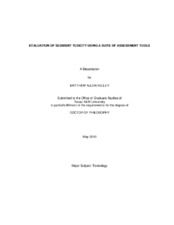| dc.contributor.advisor | McDonald, Thomas | |
| dc.creator | Kelley, Matthew A | |
| dc.date.accessioned | 2013-10-02T20:45:58Z | |
| dc.date.available | 2013-10-02T20:45:58Z | |
| dc.date.created | 2010-05 | |
| dc.date.issued | 2010-01-15 | |
| dc.date.submitted | May 2010 | |
| dc.identifier.uri | https://hdl.handle.net/1969.1/ETD-TAMU-2010-05-7690 | |
| dc.identifier.uri | https://hdl.handle.net/1969.1/149206 | |
| dc.description.abstract | Accurate characterization of risk of adverse ecological effects related to contaminated sediment presents a particularly difficult challenge. A series of studies has been conducted to investigate the utility of various tools for assessment of sediment toxicity. The goal of this research was to provide information which could help increase the accuracy with which predictions of toxicity could be made at hazardous sites.
A calibration study was conducted using model PAHs, PCBs, a binary PAH mixture and a coal-tar mixture. This study was a collaborative effort among five university-based Superfund Research Programs (SRPs). Each program, with the help of funding through the NIEHS Superfund Research Program, has developed a chemical-class specific assay to estimate toxicity of contaminants in sediment. This suite of bioassays expands the range of data typically obtained through the use of standard aquatic toxicity assays.
A series of caged in situ exposure studies has been conducted using juvenile Chinook salmon and Pacific staghorn sculpin in the Lower Duwamish Waterway. The study aimed to investigate the utility of selected biomarkers in evaluating the relationship between contaminants present in environmental samples and response in receptors following an in situ caged exposure. Results found that DNA adducts detected in exposed fish were significantly higher than controls in 2004 and 2006, and DNA adducts appear to be a reliable indicator of exposure, although no dose-response relationship was present. Western blot analysis of CYP1A1 was not indicative of exposure levels.
The final study conducted was concerned with evaluating the utility of using solid phase microextraction (SPME) fibers in situ to evaluate contaminated sediment. Levels of PAHs and PCBs in sediment often exceeded sediment quality guidelines; however, results from aquatic toxicity bioassays using Hyalella azteca were mostly negative, thus levels of contaminants detected on SPME fibers could not be associated with adverse effects in Hyalella. However, regression analysis of total PAHs present in sediment and levels of PAHs detected in porewater SPME fiber samplers, which were placed 5 cm into the sediment for 30 days, revealed a strongly correlated linear relationship (R2 = .779). Normalization of the sediment data to total organic carbon was performed to determine if the trend would remain present, and the linear relationship was again confirmed (R2 =.709). | en |
| dc.format.mimetype | application/pdf | |
| dc.subject | Sediment | en |
| dc.subject | PAHs | en |
| dc.subject | PCBs | en |
| dc.subject | DNA adducts | en |
| dc.subject | Solid Phase Microextraction | en |
| dc.subject | SPME | en |
| dc.title | Evaluation of Sediment Toxicity Using a Suite of Assessment Tools | en |
| dc.type | Thesis | en |
| thesis.degree.department | Veterinary Integrative Biosciences | en |
| thesis.degree.discipline | Toxicology | en |
| thesis.degree.grantor | Texas A&M University | en |
| thesis.degree.name | Doctor of Philosophy | en |
| thesis.degree.level | Doctoral | en |
| dc.contributor.committeeMember | Duncan, Bruce | |
| dc.contributor.committeeMember | Phillips, Timothy | |
| dc.contributor.committeeMember | Sayes, Christie | |
| dc.type.material | text | en |
| dc.date.updated | 2013-10-02T20:45:58Z | |


